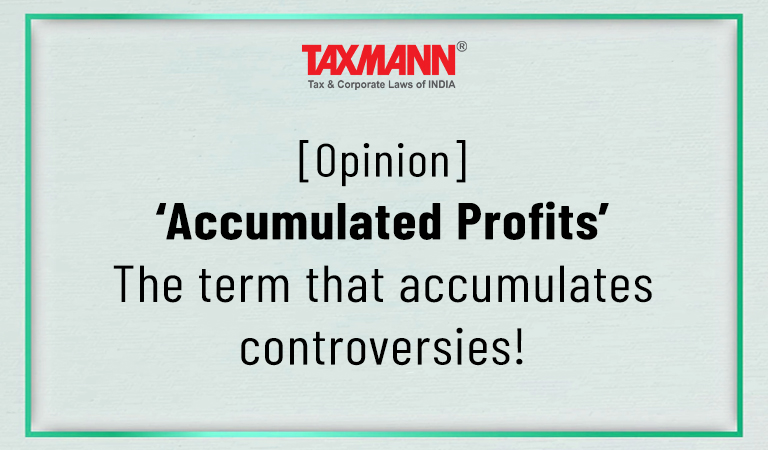[Opinion] ‘Accumulated Profits’ – The term that accumulates controversies!
- Blog|News|Income Tax|
- 3 Min Read
- By Taxmann
- |
- Last Updated on 24 November, 2022

Jatin Banka – [2022] 145 taxmann.com 84 (Article)
1. Background
1.1 The term ‘accumulated profits’ is of significant importance for the purpose of taxation of dividends under the Income-tax Act, 1961 (‘the Act’). The very foundation of taxation of dividends under section 2(22) of the Act is the existence of profits, whether accumulated or current profits. Dividends are taxable under section 2(22) of the Act to the extent of the accumulated profits available in the hands of the distributing/payer company.
1.2 Under the previous law of Indian Income-tax Act, 1922, the term ‘accumulated profits’ was not defined. Accordingly, if distribution/payment happened in the middle of the financial year, dispute arose as to whether accumulated profits would include current year’s profits, i.e. the profits of the financial year in which distribution/payment takes place or whether the quantum of accumulated profits was restricted to profits of prior years.
1.3 Based on preponderant judicial views, it was a settled position under the 1922 Act that ‘accumulated profits’ should not include ‘current profits’ i.e., the profits of the financial year in which distribution/payment takes place. In this regard, the Hon’ble Bombay High Court in case of CIT v. P.K. Badiani [1970] 76 ITR 369 observed that the term ‘accumulated profits’ under 1922 Act would mean the profits which have been accumulated before the beginning of the accounting year and held that the current year’s profits cannot be included in ‘accumulated profits’. The relevant extracts of the decision are reproduced below:
“Question No. 2 raised at the instance of the assessee raises the question whether the development rebate reserve provided for the accounting year 1957 alone would constitute “accumulated profits” of the company within the meaning of section 2(6A)(e) to the exclusion of the development rebate reserve provided in earlier years. Now, the word “accumulated” in the phrase “accumulated profits” in section 2(6A)(e) clearly indicates that “accumulated profits” mean, profits which have been accumulated before the beginning of the accounting year which would be the previous year relevant to the assessment year. The provision of section 2(6A)(e) may fall for consideration during that previous year and at that point of time it would not be even possible to know whether in that previous year there were any profits or to ascertain their amount and even if there were profits of that previous year up to that point of time, whether they would not be wiped out during the subsequent period of that previous year. The profits of that previous year would be current profits as distinguished from “accumulated profits”. Therefore, the profits of that previous year cannot be included in “accumulated profits”
[emphasis added]
1.4 Similarly, the Hon’ble Supreme Court in case of CIT v. V. Damodaran [1979] 2 Taxman 397/[1980] 121 ITR 572, relying upon judicial precedents on the subject, held that the term ‘accumulated profits’ in section 2(6A) of the 1922 Act cannot be construed to include current profits.
1.5 Subsequently, vide 1961 Act, Explanation 2 to section 2(22) was introduced to expands scope of the term accumulated profits to include profits up to the date of distribution/payment or the date of liquidation, as the case may be. The relevant extract of Explanation 2 to section 2(22) of the Act is reproduced below:
“Explanation 2.—The expression “accumulated profits” in sub-clauses (a), (b), (d) and (e), shall include all profits of the company up to the date of distribution or payment referred to in those sub-clauses, and in sub-clause (c) shall include all profits of the company up to the date of liquidation, but shall not, where the liquidation is consequent on the compulsory acquisition of its undertaking by the Government or a corporation owned or controlled by the Government under any law for the time being in force, include any profits of the company prior to three successive previous years immediately preceding the previous year in which such acquisition took place.”
[emphasis added]
Click Here To Read The Full Article
Disclaimer: The content/information published on the website is only for general information of the user and shall not be construed as legal advice. While the Taxmann has exercised reasonable efforts to ensure the veracity of information/content published, Taxmann shall be under no liability in any manner whatsoever for incorrect information, if any.

Taxmann Publications has a dedicated in-house Research & Editorial Team. This team consists of a team of Chartered Accountants, Company Secretaries, and Lawyers. This team works under the guidance and supervision of editor-in-chief Mr Rakesh Bhargava.
The Research and Editorial Team is responsible for developing reliable and accurate content for the readers. The team follows the six-sigma approach to achieve the benchmark of zero error in its publications and research platforms. The team ensures that the following publication guidelines are thoroughly followed while developing the content:
- The statutory material is obtained only from the authorized and reliable sources
- All the latest developments in the judicial and legislative fields are covered
- Prepare the analytical write-ups on current, controversial, and important issues to help the readers to understand the concept and its implications
- Every content published by Taxmann is complete, accurate and lucid
- All evidence-based statements are supported with proper reference to Section, Circular No., Notification No. or citations
- The golden rules of grammar, style and consistency are thoroughly followed
- Font and size that’s easy to read and remain consistent across all imprint and digital publications are applied




